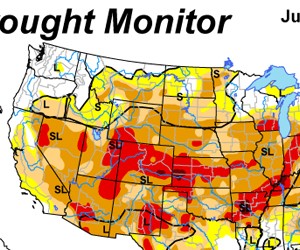Federal Water Tap, July 23: Alaska Submits Study Plan for Large Dam
The Susitna-Watana Hydroelectric Project envisions a dam 700 feet tall capable of producing 600 megawatts from a 39-mile-long reservoir on the Susitna River in south-central Alaska. It would generate half the electricity currently produced in the state’s most populous region, and it would be the largest dam built in the United States since the late 1960s. Last week, the state agency tasked with developing the project submitted its study plan to federal regulators.
The 1,261-page plan includes 58 individual studies, which will assess technical and environmental impacts for soils, geology, water resources, fish and wildlife, among others. All studies are expected to be completed by March 2015, and the project itself by 2023. Public comments on the proposed study plan are due to the Federal Energy Regulatory Commission by October 15.
Military Base Water Contamination
The Senate passed a bill to pay the health-care costs of thousands of Marines and their family members who drank contaminated water while living at Camp Lejeune in North Carolina. McClatchy reports that the bill will help as many as 750,000 people who lived or worked on the base between 1957 and 1987 and were exposed to benzene and industrial chemicals in the water supply.
House Hearing: Water Infrastructure
A House subcommittee will hold a hearing on July 25 to discuss the Environmental Protection Agency’s new guidelines for making investments in sewer and stormwater infrastructure. The EPA’s top water official will be on one panel; the other features state and local water officials, speaking on behalf of national water organizations.
Senate Hearing: Natural Gas
On July 24, the full Senate Energy and Natural Resources Committee will discuss natural gas as a transportation fuel.
Senate Hearing: Water and Energy
On July 25, a Senate subcommittee will look at water-use efficiency and how it affects energy use.
Tribes and Climate Change
Land swaps and renewable energy programs, along with better coordination with federal agencies were some of the suggestions to a Senate committee for how to help Indian tribes cope with the effects of climate change, McClatchy reports.
Groundwater Quality
Continuing its research into groundwater quality in the nation’s major aquifers used for drinking water, the U.S. Geological Survey found nitrates the most common contaminant in the Upper Santa Ana watershed, in southern California. Perchlorate, used in rocket fuel and some fertilizers, was second-most common, occurring in concentrations above state health standards in 11 percent of the aquifers in the study area. The researchers tested untreated water samples, not water delivered to customers.
“Results from this study indicate that human activities in industry and agriculture are the primary factors affecting local groundwater quality throughout the Inland Empire aquifer system,” said Robert Kent, a USGS hydrologist and lead author of the report, in a statement.
Forests and Lakes Meetings
The U.S. Forest Service is starting the environmental review process for a proposed forest and watershed restoration project on 44,515 hectares (110,000 acres) in Santa Fe National Forest in New Mexico. Public meetings to discuss the project begin this week.
The International Joint Commission, which manages surface water shared by the U.S. and Canada, will hold public meetings this week on renewing the water management agreement for Lake Osoyoos, a reservoir in the Columbia River Basin.
Federal Water Tap is a weekly digest spotting trends in U.S. government water policy. To get more water news, follow Circle of Blue on Twitter and sign up for our newsletter.
Brett writes about agriculture, energy, infrastructure, and the politics and economics of water in the United States. He also writes the Federal Water Tap, Circle of Blue’s weekly digest of U.S. government water news. He is the winner of two Society of Environmental Journalists reporting awards, one of the top honors in American environmental journalism: first place for explanatory reporting for a series on septic system pollution in the United States(2016) and third place for beat reporting in a small market (2014). He received the Sierra Club’s Distinguished Service Award in 2018. Brett lives in Seattle, where he hikes the mountains and bakes pies. Contact Brett Walton





Leave a Reply
Want to join the discussion?Feel free to contribute!